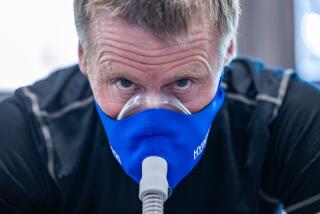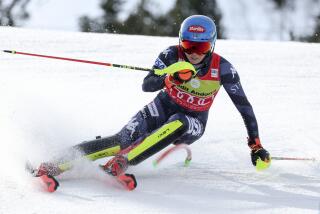Now, It’s All Downhill : Skiing’s Mahre Twins Seem to Be Enjoying Their Early but Active Retirement
- Share via
DILLON, Colo. — Phil Mahre, the best American skier in history, retired last spring. Like most retirees, he took a cut in pay.
At 27, the three-time World Cup champion and his twin brother, Steve, decided to chuck it all and embark early on their golden years.
Trouble is, the year since hasn’t been as golden as, say, the five preceding it. But do they miss the rat race that annually extends from Val d’Isere to Aspen by way of Japan?
“Not a bit,” Phil said the other day at Keystone, where he had just finished greeting 35 students in his weeklong Mahre Training Center program. “It’s really good, now. Fantastic. I watched some races, and I was glad it was them out there, not me. Stephen feels the same way.”
Phil was wearing a beige pullover sweater with the initials TWN where the alligator usually is. That also happens to be the name of the holding company that he and Steve and their business partners, Barry Gordinier, Bill Kirshner and Terry Heckler, formed in Seattle to handle the twins’ business matters.
“We couldn’t call it TWIN because that’s a generic word,” Heckler said later.
TWN’s current activities include:
--A line of ski and apres-ski clothing (including Phil’s sweater).
--The Mahre Training Centers, which should actually be singular now, although negotiations are under way to set up three more.
--Water-ski boats (the Ski Centurion) and sailboards.
--Commercials for companies such as DuPont and Canon.
--Continued tie-ins with ski-equipment suppliers, including K2 skis, Lange boots, Marker bindings and Smith goggles, all of which were renewed for four years after the 1984 Winter Olympics.
Obviously, there’s no need to take up a collection for the Mahre brothers, even if they aren’t eligible for Social Security, yet.
But Phil said: “I’m making less money now than when I was racing. For one thing, there’s no more bonus money from the victory schedules.”
Top-level ski racers on the World Cup circuit are technically amateurs, but they are permitted to enter into contracts with various companies in the ski industry and receive money in the form of “broken-time payments” for using these companies’ equipment (or clothing). Although nobody still active will admit it for the record, these agreements also contain clauses that give racers additional sums, on a graduated scale, for first places, top-10 finishes, Olympic and world-championship medals.
Asked about this, Inez Aimee, executive director of the U.S. Ski Team for three years until last fall, said: “To my knowledge, there were no victory clauses in the contracts of American racers.”
And Michael Harrigan, who succeeded Aimee, said: “Victory clauses are definitely illegal under the rules of both the International Skiing Federation (FIS) and the International Olympic Committee, although of course, I have heard rumors of their existence.”
According to Phil Mahre, though, they’re more than rumors. In fact, toward the end of his racing career, they helped boost his income to about $600,000 annually.
One source on the team said: “Phil won so many races and titles that one company wound up having to give him stock to cover the victory schedules.”
Steve Mahre, the same source estimated, earned about half as much as Phil.
Besides the ski-industry contracts, which are supposed to be channeled through the team, racers may also earn money with endorsements and appearances, but the team claims a percentage of that money, and the remainder goes into a trust fund to be paid upon retirement from amateur competition.
This, incidentally, is where Harrigan and Bill Johnson, the 1984 Olympic downhill champion, are at odds.
Johnson and his father-agent, Wally, resent having to give the U.S. Ski Team a penny for deals that they negotiate on their own, including the one for the movie he made for TV, “Guts and Glory, the Bill Johnson Story.”
Said Harrigan: “They got taken on that deal.”
And Aimee, who doubts that Johnson has made anything close to the millions he envisioned at Sarajevo, Yugoslavia, said: “The movie may be his first substantial reward. I think Bill might also want to address the question of his amateur eligibility. He could end up being ineligible for the team.”
Phil Mahre, who calls Johnson “young and immature,” has always taken the opposite approach to money, preferring to keep a low financial profile. Over the years, he repeatedly said: “It doesn’t mean that much to me. I’m not in ski racing for the money. I love the sport.”
Now, however, he’s out there hustling with everyone else.
When not pursuing his TWN interests, Phil has picked up some loose change by finishing fifth among 20 entrants in the “Superstars” TV competition, and he has become a journalist, teaming with Steve as contributing editors to Ski magazine.
“I’m also writing a book, with John Fry,” Phil said. “It’s about my career, but it includes a section on skiing technique. The publishers (Simon and Schuster) insisted on that.”
Eventually, the Mahres intend to write another book, strictly on ski racing, in collaboration with Harald Schoenhaar, Alpine director of the U.S. Ski Team.
Schoenhaar was involved in the planning of the Mahre Training Centers but dropped out when he moved up to his present job. The center at Keystone operates as part of the resort’s regular ski school, using instructors who have received special training from the Mahres.
“The program is for skiers at all levels of ability, not just racers,” Phil said. “We’ve even had some first-time beginners spend the week here.”
Originally, the idea was for the twins to alternate at the sessions, but Steve injured a knee while skiing at White Pass, Wash., so Phil has been doing double duty, greeting each class Sunday evening and then skiing with them Monday and Tuesday before turning them over completely to their instructors.
By next season, it is hoped, there will be Mahre Training Centers at Heavenly Valley or someplace else in the Lake Tahoe Basin, in the Midwest and in the East.
“When that happens, we’ll probably schedule four weeks at Keystone and three weeks at each of the others,” Mahre said. “Either Stephen or I will visit each session.
“I’m still on the road a lot, but at least now I can get home. And I’m on my own time. Someone isn’t telling me where and when to go someplace.”
Home is in Yakima, Wash., where Phil’s second wife, Holly, keeps busy minding daughter Lindsey, 2 1/2, and son Alexander, who celebrated his first birthday Feb. 19--which also happened to be the first anniversary of his dad’s gold medal--and his uncle’s silver medal--in the Olympic slalom at Sarajevo.
The twins live about 16 miles apart, Phil in a new house that he spent several summers building, and Steve, also with a wife and two youngsters, in an 80-year-old house he is remodeling--with help from Phil.
“My house isn’t quite finished,” Phil said. “It still needs a little trim here and there, but I’m so busy in the winter. When summer comes, I like to play . . . go water-skiing or something. Or else, I’ll help out Stephen. I hate to just stay around the house.
“You know, physically, I’m still in great shape. I could have gone on racing forever, but mentally, it was impossible to continue at that pace.”
Asked how Ingemar Stenmark, his longtime rival and also a former World Cup champion, can still go out there on the circuit at 28, Phil cited the Swede’s inability to win a race so far this season as further evidence to support his own decision. “He doesn’t have the hunger anymore that the others have,” Phil said. “He’s got a wife and kid. It’s different for him now.”
It’s different for Phil Mahre now, too, involving maybe a little more work for a little less money. But basically, he hasn’t changed from the way former U.S. Ski Team Coach Bob Beattie indirectly described him after seeing his house under construction. Asked what the house looked like, Beattie said: “Well, you know, it’s kind of like Phil--solid and square.”
More to Read
Go beyond the scoreboard
Get the latest on L.A.'s teams in the daily Sports Report newsletter.
You may occasionally receive promotional content from the Los Angeles Times.






